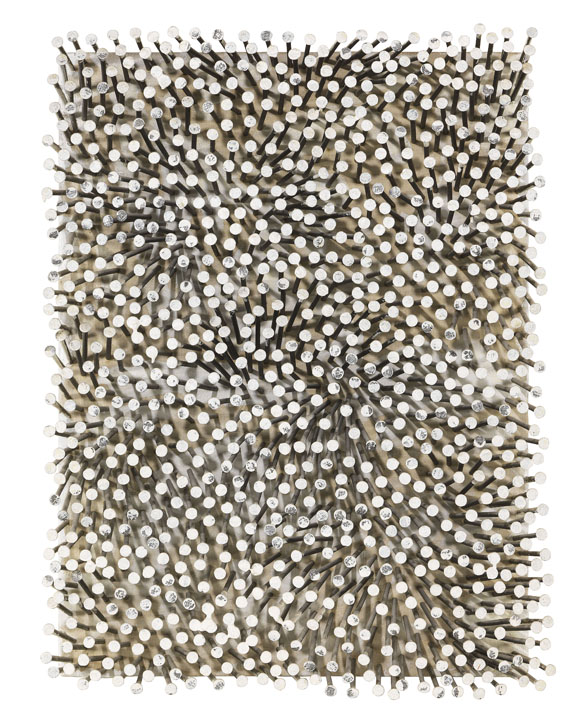1230
Günther Uecker
Feld, 1994.
Estimation:
€ 50,000 / $ 58,000 Résultat:
€ 152,500 / $ 176,900 ( frais d'adjudication compris)
Feld. 1994.
Nail and white paint on canvas and on wood.
Not in Honisch any longer. Verso signed, dated and with arrow indicating the direction. With inscription "Wassermann München" on folded canvas . Ca. 41 x 32 x 9 cm (16,1 x 12,5 x 3,5 in).
Accompanied by a photograph confirmed by Professor Günther Uecker. We are gratefult o Prof. Günther Uecker and his wife, Düsseldorf, for their kind support in cataloging this lot.
PROVENANCE: Private collection Southern Germany.
EXHIBITION: Galerie Waßermann, Munich (verso with gallery stamp).
Günther Uecker was born in Wendorf, Mecklenburg on 13 March 1930. He began his artistic education in 1949 when he took up studies at Wismar. He then went to the art school in Berlin-Weißensee and in 1955 to Düsseldorf. Here Uecker studied under Otto Pankok at the Kunstakademie where he has also been teaching since 1974. He made his first nail pictures towards the end of the 1950s. Uecker met the group ZERO with Heinz Mack and Otto Piene in 1960, artists who propagated a new beginning of art in opposition to the German Informel. He occupied himself with the medium of light, studied optical phenomena, series of structures and the realms of oscillation which actively integrate the viewer and enable him to influence the visual process by kinetic or manual interference. Uecker, Mack and Piene began working together in joint studios at the Stedelijk Museum in Amsterdam in 1962 and installed a 'Salon de Lumière' at the Palais des Beaux-Arts in Paris. Other 'light salons' followed in Krefeld and in Frankfurt. Since 1966, after the group ZERO dissolved and a last joint exhibition, Uecker increasingly used nails as an artistic means of expression - a material which, until today, stands in the centre of his oeuvre. At the beginning of the 1960s he began hammering nails into pieces of furniture, musical instruments and household objects, then he began combining nails with the theme of light, creating his series of light nails and kinetic nails and other works. Light and electricity continued to be one of the main subjects and natural materials such as sand and water were included in his installations, resulting in an interaction of the different elements to create a sensation of light, space, movement and time.
Günther Uecker's oeuvre includes painting, object art, installations as well as stage designs and films. His origins explain his interest in the eastern European avant-garde of the 1920s and 1930s, but he is likewise interested in Asian cultures and their ideas. His works can be seen in collections and large fairs in the West as well as the East. Uecker's artistic creativity reached a peak in 2000 in the prayer room he designed for the Berlin Reichstag building. Günther Uecker teaches, lives and works in Düsseldorf. [KP].
Nail and white paint on canvas and on wood.
Not in Honisch any longer. Verso signed, dated and with arrow indicating the direction. With inscription "Wassermann München" on folded canvas . Ca. 41 x 32 x 9 cm (16,1 x 12,5 x 3,5 in).
Accompanied by a photograph confirmed by Professor Günther Uecker. We are gratefult o Prof. Günther Uecker and his wife, Düsseldorf, for their kind support in cataloging this lot.
PROVENANCE: Private collection Southern Germany.
EXHIBITION: Galerie Waßermann, Munich (verso with gallery stamp).
Günther Uecker was born in Wendorf, Mecklenburg on 13 March 1930. He began his artistic education in 1949 when he took up studies at Wismar. He then went to the art school in Berlin-Weißensee and in 1955 to Düsseldorf. Here Uecker studied under Otto Pankok at the Kunstakademie where he has also been teaching since 1974. He made his first nail pictures towards the end of the 1950s. Uecker met the group ZERO with Heinz Mack and Otto Piene in 1960, artists who propagated a new beginning of art in opposition to the German Informel. He occupied himself with the medium of light, studied optical phenomena, series of structures and the realms of oscillation which actively integrate the viewer and enable him to influence the visual process by kinetic or manual interference. Uecker, Mack and Piene began working together in joint studios at the Stedelijk Museum in Amsterdam in 1962 and installed a 'Salon de Lumière' at the Palais des Beaux-Arts in Paris. Other 'light salons' followed in Krefeld and in Frankfurt. Since 1966, after the group ZERO dissolved and a last joint exhibition, Uecker increasingly used nails as an artistic means of expression - a material which, until today, stands in the centre of his oeuvre. At the beginning of the 1960s he began hammering nails into pieces of furniture, musical instruments and household objects, then he began combining nails with the theme of light, creating his series of light nails and kinetic nails and other works. Light and electricity continued to be one of the main subjects and natural materials such as sand and water were included in his installations, resulting in an interaction of the different elements to create a sensation of light, space, movement and time.
Günther Uecker's oeuvre includes painting, object art, installations as well as stage designs and films. His origins explain his interest in the eastern European avant-garde of the 1920s and 1930s, but he is likewise interested in Asian cultures and their ideas. His works can be seen in collections and large fairs in the West as well as the East. Uecker's artistic creativity reached a peak in 2000 in the prayer room he designed for the Berlin Reichstag building. Günther Uecker teaches, lives and works in Düsseldorf. [KP].
1230
Günther Uecker
Feld, 1994.
Estimation:
€ 50,000 / $ 58,000 Résultat:
€ 152,500 / $ 176,900 ( frais d'adjudication compris)




 Lot 1230
Lot 1230 